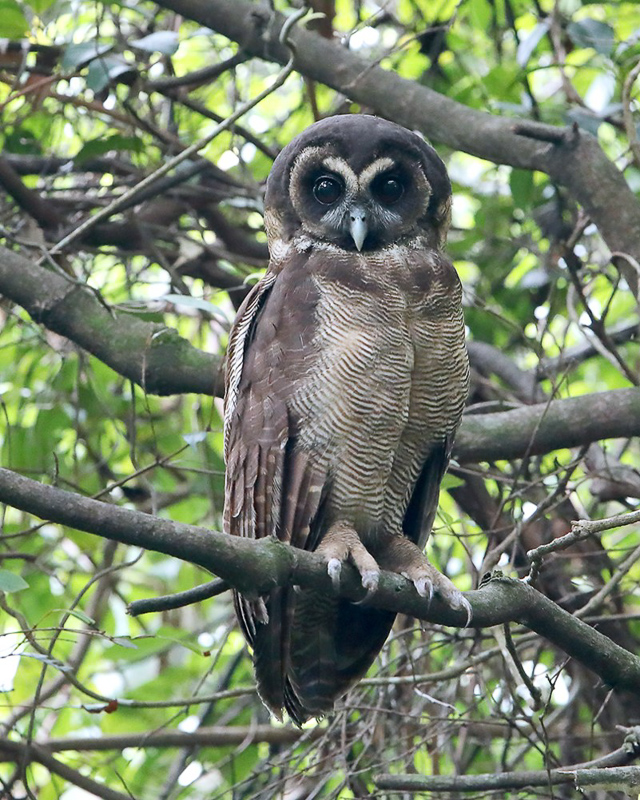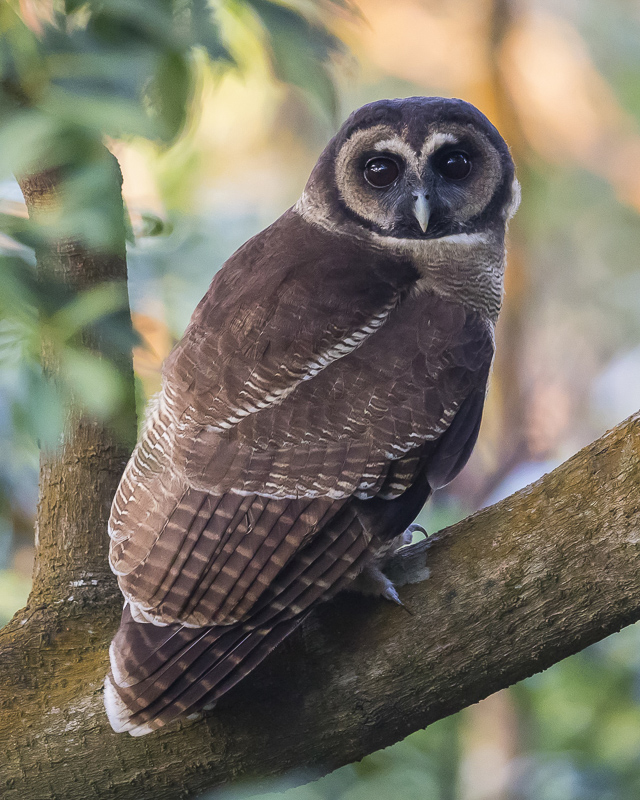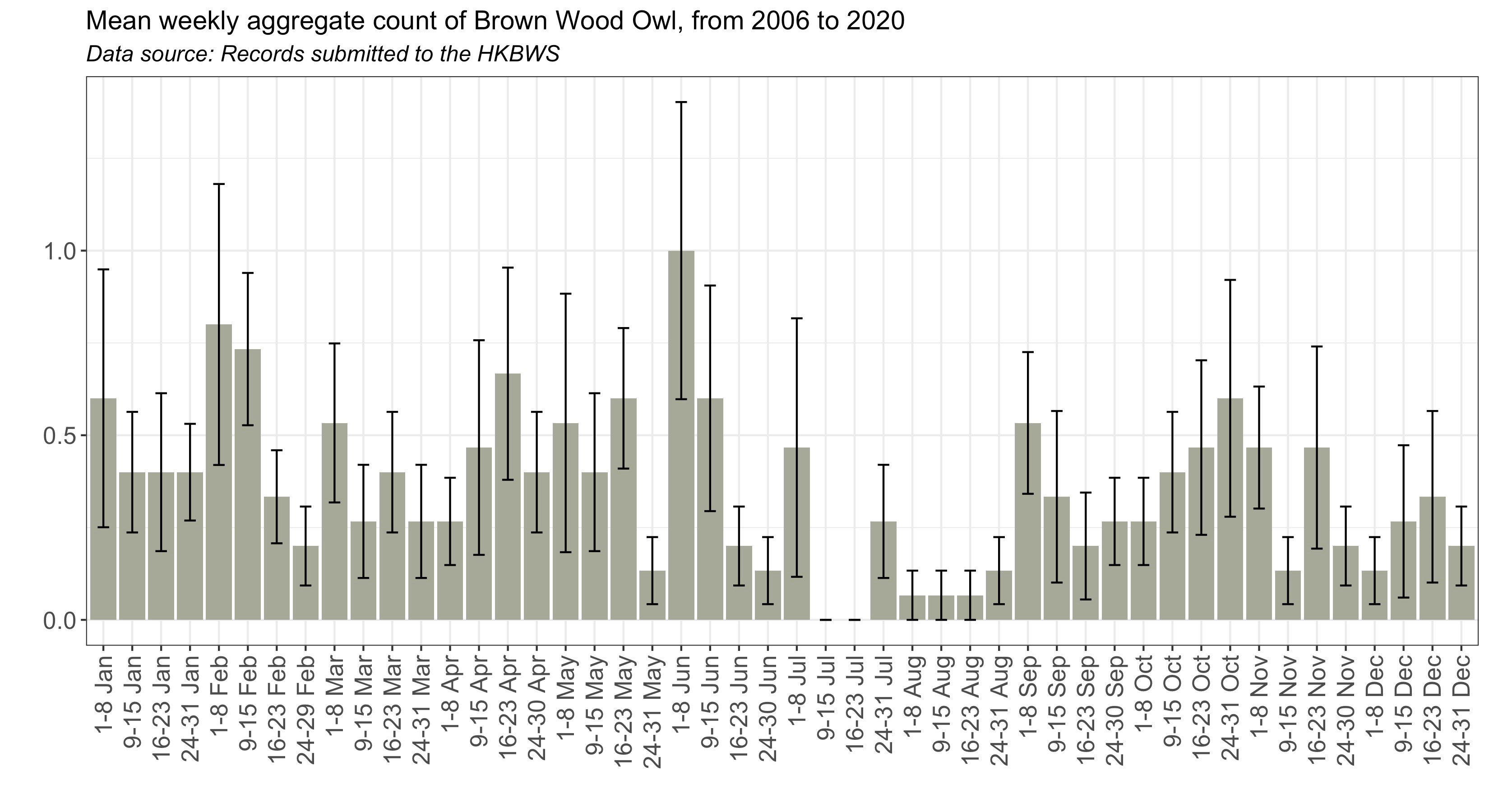Brown Wood Owl Strix leptogrammica 褐林鴞
Category I. Scarce but increasing resident, first recorded in 2006.
IDENTIFICATION

Jun. 2018, Michelle and Peter Wong. Adult.
46-55 cm. A large powerful owl with a rounded head (lacking ear-tufts), finely-barred pale underparts, fully feathered legs and dark eyes. On adults, the facial disc is pale with a broad dark rim, dark patches around the eyes and bill, and a conspicuous broad whitish supercilium which curves up from above the bill; a white throat patch is also conspicuous on some views.

Oct. 2019, Matthew Kwan. Adult.
The deep brown upperparts are marked by a prominent white scapular line and the primaries are tipped whitish.

Jun. 2010, Martin Hale. Juvenile.
Recently-fledged juveniles retain much of the downy white plumage of the nestling stage on the head, breast and underparts but have a black-rimmed tawny-brown facial disc and adult-type feathers on the wings and tail (Kilburn 2013).
VOCALISATIONS
Territorial calls noted in HK are a deep four-note ‘hoo hoo-hoo-hoo’ and a three-note ‘ooh-hoo hoo.’
Also gives a drawn out modulated screeching whinny.
DISTRIBUTION & HABITAT PREFERENCE
Distributed at altitudes of about 100-550m in the New Territories, especially the Tai Mo Shan massif and extensions, and also locally in the northeast, east and southeast parts. It occurs in mature woodland with large trees, especially secondary forest and fung shui woods with connectivity to regenerating woodland (Kilburn 2013). Favoured sites include Tai Po Kau and the Lam Tsuen Valley.
OCCURRENCE
Records are in all months and predominantly of one or two vocalising birds, some of which are occasionally also seen. The first six months of the year account for almost 70% of records; in the remaining months, troughs are apparent in July-August and December (Figure 1), though this is likely due to reduced vocal activity.
An adult photographed at Lead Mine Pass on 6 November 2007 (Wong 2011) was the first accepted record and led to acceptance of an earlier record of a bird sound-recorded in Tai Po Kau on 18 and 20 March 2006. Two sites, Lam Tsuen and Tai Po Kau, accounted for nearly all records to the end of 2012 after when the number of sites with records steadily increased to the end of 2018, followed by a sharp rise in both annual totals and number of sites in the years 2019-2021, though this was related to the carrying out of a nightbird survey.
BREEDING
There are no observations of adults incubating eggs or brooding chicks, but as summarised by site below, there were eight breeding records between 2009 and 2020, two involving chicks. Taken together these indicate that chicks hatch in late March or April and fledge in May, and that juveniles subsequently remain in the nest-site area through June and into early July. The only nest found was in a tree-hole c. 1.8 metres above the ground in a fung shui wood.
Tai Mo Shan CP. A very young chick was found on 4 April 2009 and taken into care at KFBG (Tan et al. 2011, Kilburn 2013). It had probably hatched in late March.
Lam Tsuen Valley. One or two young birds have been recorded, usually with one or two adults nearby, in five years from 2010 to 2018 in the period 10 May to 10 June in the same fung shui wood on a steep northwest-facing slope at about 100 metres asl. The only record of an unfledged chick involved one in a nest in a tree-hole on 10 May 2018.
KFBG. A juvenile, which was either close to fledging or had fledged very recently, was seen on 1 May 2015, with adults close by. It was last seen in the area on 15 May.
Tai Lam CP (Kap Lung). One fledged young on 9 June and 2 July 2020, with one or two adults close by on both dates.
Konig and Weick (2008) reported that northern subspecies were not known to use tree-holes as nest-sites. There is, however, a recent record of tree-hole nesting in Taiwan (Lin et al. 2008).
BEHAVIOUR, FORAGING & DIET
Mainly nocturnal, though occasionally vocal by day. Forages within the canopy. One released from KFBG and radio-tracked for over 30 days roosted at sites with mature trees and showed a reluctance to cross roads or open areas (Tan et al. 2011). Pellets found below a roost-site at KFBG used by an adult contained the remains of Short-nosed Fruit Bats Cynopterus sphinx (KFBG 2020).
RANGE & SYSTEMATICS
Widely distributed from the northwest Himalayas east through Burma and north Indochina to Hainan, southeast China and Taiwan, and also south to southern India, Sri Lanka, the Malay Peninsula, Sumatra and Borneo (Holt et al. 1999). Polytypic, with the taxon ticehursti occurring in south China from Yunnan east to Zhejiang and caligata on Hainan and Taiwan. Based on differences in size, colouration and vocalisations between northern and southern taxa, recognition of a separate polytypic species covering the four northern subspecies (newarensis, ticehursti, caligata and laotiana) was proposed by Holt et al. (1999) and supported by Konig and Weick (2008) under the name “Strix newarensis”.
CONSERVATION STATUS
IUCN: Least Concern. Population trend decreasing.
Figure 1.

Holt, D. W., R. Berkley, C. Deppe, P. L. Enríquez Rocha, J. L. Petersen, J. L. Rangel Salazar, K. P. Segars and K. L. Wood (1999). Species accounts of Brown Wood-owl Strix leptogrammica. p. 197-198 in del Hoyo, J., Elliot, A. and Sargatal, J. Handbook of the Birds of the World, vol. 5: Barn-owls to Hummingbirds. Lynx Edicions, Barcelona, Spain.
KFBG (2020). KFBG blog: What’s on a Brown Wood Owl’s menu? Downloaded from: https://www.kfbg.org/en/KFBG-blog/post/Whats-on-a-Brown-Wood-Owls-menu?fbclid=IwAR2ZzLsTnskQEXu_8JXrOWc9udxUETFJJw83o5ruIoZGCEorzivrGu8jPT0
Kilburn, M. (2013). The First Breeding Records, Ecology, Status, and Conservation of Brown Wood Owl Strix leptogrammica ticehursti in Hong Kong. Hong Kong Bird Report 2011: 210-233.
Konig, C. and F. Weick (2008). Owls of the World (2nd ed). Christopher Helm, London.
Lin, W. L., H. Y. Tseng, Y. Wang and M. D. Chen (2008). Breeding Ecology, Food Habits and Hunting Behaviour of the Himalayan Wood Owl Strix newarensis. Endemic Species Research 10 (2): 13-24. [in Chinese] https://tesri.tesri.gov.tw/files/tesri_protect/177/087912613_pdf.pdf
Tan, K. S., C. H. Ko, P. Crow, A. Grioni, D. Ng, L. Fung, C. H. Poon, R. C. Kendrick, G. W. J. Ades and R. Griffiths (2011). Post Release Monitoring of a Rehabilitated Brown Wood Owl (Aves: Strigiformes, Strigidae, Strix leptogrammica) in Hong Kong Special Administrative Region, China. Kadoorie Farm & Botanic Garden Publication Series. Number 7.
Wong, C. O. (2011). Brown Wood Owl Strix leptogrammica ticehursti at Lead Mine Pass, Shing Mun: the first Hong Kong record. Hong Kong Bird Report 2007-08: 253-257.

